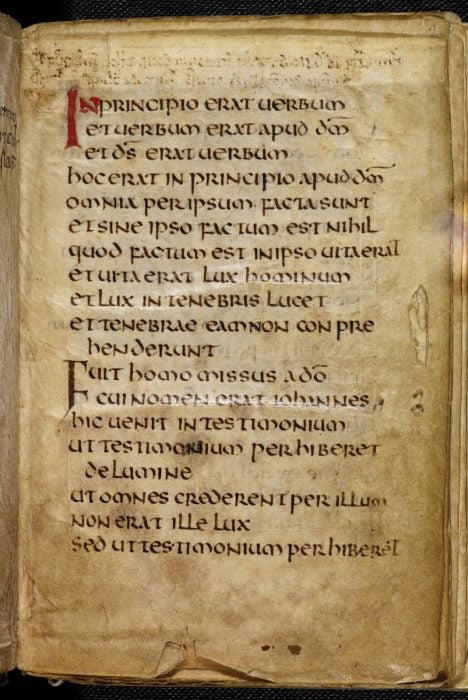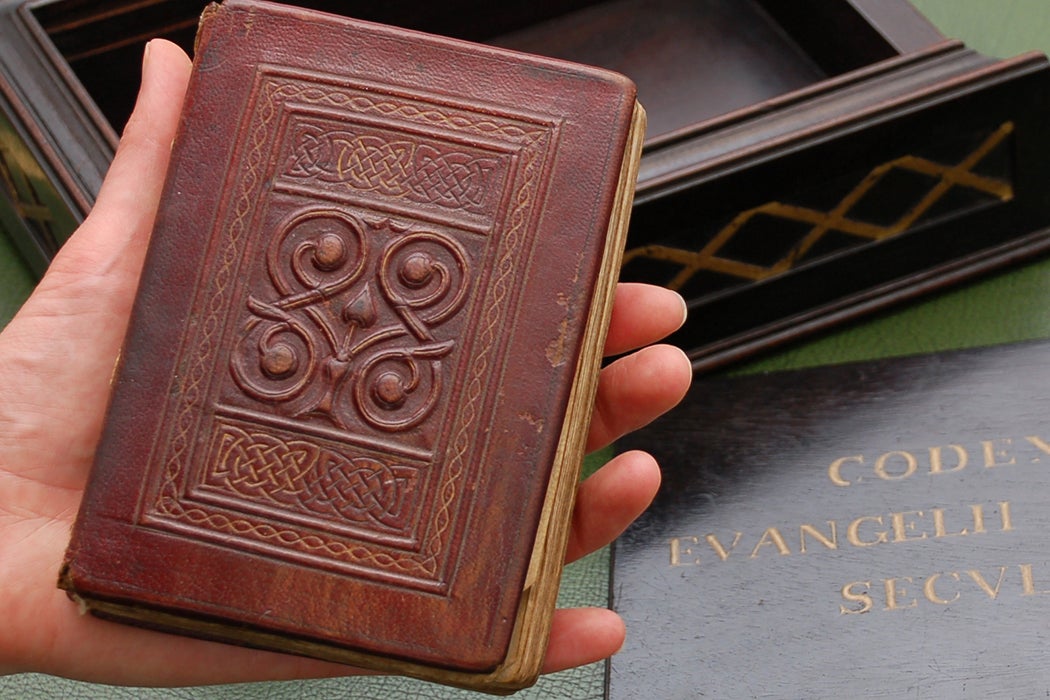Saint Cuthbert’s fame grew following his death in 687. The hermit monk’s body, so the story goes, was found to be incorrupt over a decade after his passing in Northumbria (today’s border between England and Scotland). The miracle led to a cult around his remains. Offerings were placed at his tomb. Some time around 698, a small red book was slipped into his coffin.
This manuscript — known as the St. Cuthbert Gospel, or Stonyhurst Gospel (for Stonyhurst College where it was once held) — is the earliest surviving intact European book. It was removed from Cuthbert’s coffin in 1104, during a transfer of the saint’s remains to a new shrine in Durham Cathedral. “In an eyewitness account of the events surrounding the ceremony of Translation, which took place on Monday, August 29, 1104, [an] anonymous writer describes an investigatory opening of the coffin on the night of Thursday, August 25,” writes literature professor Calvin B. Kendall in The Journal of English and Germanic Philology. “After examining Cuthbert’s body for evidence of incorruption, the monks reclothed it with costly garments and restored it to the coffin, and ‘As soon as the body of the blessed Father was shut up in the coffin, they covered the coffin itself with linen cloth of a coarse texture, dipped in wax.’”
The book, however, was kept as a separate relic. Today the 1,300-year-old manuscript retains its original pages and binding. It was acquired by the British Library in 2012, and will be on view in the London institution’s Anglo-Saxon Kingdoms: Art, Word, War, opening October 19th.

“Its excellent state of preservation can be traced at the outset to the significance it held — a carefully prepared gospel text, which was transferred with the relics of St. Cuthbert to Durham in 1104,” writes scholar Robert D. Stevick in Artibus et Historiae. Because of this remarkable condition, it’s an important example of Insular art, which was created on the British Isles and Ireland between 600 and 900 CE. “There is interlace pattern in two panels on the front cover, step-pattern implying two crosses on the lower cover, a prominent double vine scroll at the center of the front cover—elements of this early art that have been well catalogued for their individual features as well as for their affinities to similar decorative elements in other artifacts,” notes Stevick.
Get Our Newsletter
The design of the book is simple but elegant, with its dyed leather cover adorned with this geometric floral design. Inside, its construction reflects the transmission of publishing knowledge across Europe. The binding has an “unsupported” sewing technique with threads linking to stitches on a previously sewn section. “This link-stitch method developed around the Mediterranean and is regarded as the earliest type of codex sewing,” explains book conservator Scott Husby in The Princeton University Library Chronicle. “Often referred to as Coptic sewing because of its origination with the Copts of North Africa, this technique spread widely; there are even examples of it from the medieval British Isles, the Stonyhurst Gospel being the best known. Binders from the Greek and Byzantine tradition used this chain-stitch type of sewing, as did Islamic bookbinders for many centuries.”
The text itself is also significant, as it’s a copy of the Gospel of St. John. This was not a randomly selected spiritual text. This gospel was sometimes employed as a protective talisman. “While many kinds of relic could be worn as amulets, books were particularly desirable, and there are multiple accounts of Gospels and Psalters (especially those linked with saints) being fitted with cord or placed in a pouch and worn on the body, a practice associated with books as early as the seventh/eighth-century Stonyhurst Gospel of St. Cuthbert,” writes Stuart McWilliams, lecturer in English, in Preternature: Critical and Historical Studies on the Preternatural.
The British Library has the whole St. Cuthbert Gospel available to explore online, as this rare manuscript continues its journey into the digital age.
Editor’s note: An earlier version of the story erroneously placed Northumbria in “today’s Scotland.”







